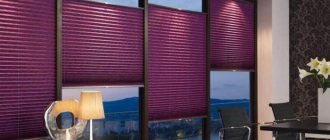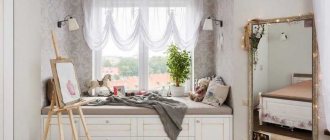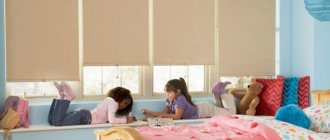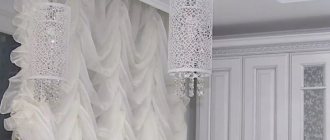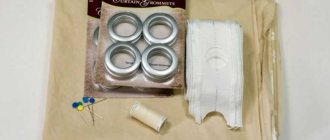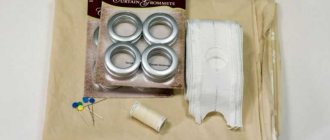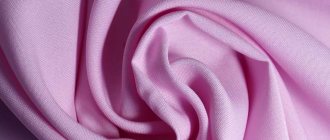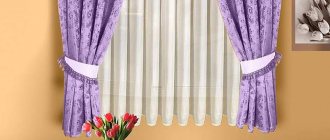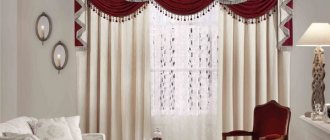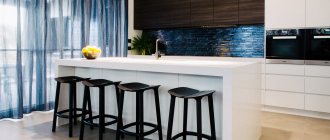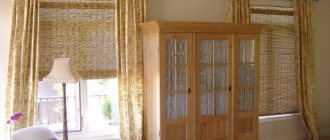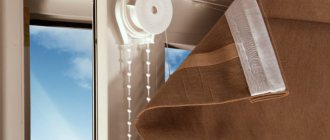Pleated curtains will be an effective alternative to classic window drapery options. They are multifunctional, suitable for openings of any shape and size, and occupy a minimum of free space. Such products can be combined with curtains or drapes, installed directly on the window sash or attached to walls or slopes.
Description of pleated curtains
This may be the name for curtains whose fabric is gathered into a fold. They do not lose their shape during use and do not sag. Due to the folds, they are easy to raise and lower, adjusting the level of light in the room. The structure can be mounted on wooden, plastic, or aluminum frames.
Corrugated curtains differ in design. They consist of two accordions fastened along the fold line. This provides an additional heat-insulating effect of the window opening due to the air gap, protects the room from overheating in the summer and from heat loss in the cold season. Due to the complexity of manufacturing, the cost of such curtains is higher compared to pleated ones.
Designers recommend installing paper curtains in rooms with minimal likelihood of contamination. This is due to the fact that such fabrics can only be dry cleaned. Wet cleaning is only possible when using moisture-resistant types of material or paintable wallpaper.
Pleating
Pleating or pleating
(French plisse; from the word le pli - fold) - a type of fabric processing with the formation of pressed folds, which can be laid on one side, can be bow, combined, straight or flared, etc. Pleated folds can be of different widths, can go across the entire width of clothing, for example, a skirt or dress, and can also be placed in groups at certain intervals.
In industrial conditions pleating
fabric is produced by the heat treatment method, which is divided into the dry method, in which the heat treatment temperature reaches 170-200°, and the steam heat treatment method, in which the fabric is wound in a roll onto a perforated pipe and steam with a temperature of 130° is passed through it.
These methods have a number of technological features, for example, some types of pleating
are obtained by steam treatment with a pressure of 0.7-1.0 atm for 10 minutes. There are separate processing nuances for different types of fabrics. In addition, to obtain stable pleating, fabrics can be treated with special chemicals.
There are also various home pleating methods.
In Russian, it is customary to separate pleated and corrugated folds (French gaufré). This division could be seen in fashion magazines of the early 20th century. In Soviet times, when all production was regulated, there were clear technological definitions, each operation had its own name, industrial methods of corrugation and pleating were always separated.
In the Russian version, pleats are flat-lying (usually from 0.5 cm to 5 cm) folds, and corrugation is a series of folds with sides of the same width, pressed onto the edge, i.e. standing ones, the general appearance of which resembles an accordion. Corrugation can also be straight or flared with various options and groupings of folds.
In modern world fashion, the term pleated is usually used (pleated skirt - English plisse skirt; French jupe plissee; German plissee rock; Italian gonna plissé; Spanish falda plisada, etc.). In the English version, pleated clothing can be referred to by the term pleating from the English. words pleat - fold (pleating skirt - pleated skirt).
In addition, there are English terms that characterize some features of the type of pleating
:
Cartridge pleating refers to a type of pleating-like folds characteristic of clothing from the 16th to 18th centuries, in which a large amount of fabric was gathered in the seam area.
Accordion folds - accordion pleat, folds, which in Russian are called corrugation.
Fortuny folds or Fortuny pleating are very small folds (pleating) on silk fabric, invented at the beginning of the 20th century by Spanish fashion designer Mariano Fortuny y Madrazo.
The technique of pleating or corrugating fabric has been known since ancient civilizations. Historical artifacts indicate that even before our era, pleating
decorated the clothes of the ancient Egyptians, Phoenicians, Greeks, inhabitants of Mesopotamia, Zapotecs - representatives of one of the most ancient civilizations of pre-Columbian Mesoamerica, which arose in the 1st millennium BC. in the modern Mexican state of Oaxaca.
At the beginning of the 20th century, British archaeologist and specialist in Egyptology Flinders Petrie found remains of fabric in the Tarkhan necropolis, located near the city of El-Fayoum, known as the most ancient city in Egypt. When the artifact was carefully examined, it was discovered that Petrie's find had once been part of a woman's pleated
. Radiocarbon dating carried out by Oxford University confirmed that the dress was made more than five thousand years ago. The research results were published in the scientific journal Antiquity Journal. Once the age of the dress was established, the researchers were able to say with confidence that it was the oldest dress known to date.
Presumably, this pleating was achieved after the fabric was treated with gelatin from fish cartilage and then dried on a special board with grooves.
During the era of the Middle Kingdom (which arose at the end of the 3rd millennium BC, and ended around 1600 BC), agriculture, crafts and trade developed in Ancient Egypt. This was a time of urban growth, expansion of trade contacts with other countries of the Ancient World, from which new fabrics were imported, which contributed to the emergence of updated forms of clothing. During this period, pleated kalaziris and long skhenti appeared (kalaziris and skhenti are traditional clothes of Ancient Egypt). The Egyptian Museum in Florence (Il Museo Egizio di Firenze) houses a unique exhibit - a corrugated wooden board, with the help of which, according to Egyptologists, the ancient Egyptians created a kind of pleating on wet fabric treated with a starch-like substance.
There is a hypothesis that in Ancient Greece, approximately in the 4th century BC. linen fabrics were pleated using a hot metal rod.
In the city of Birka (the oldest city on the territory of modern Sweden, the largest trade and craft center of the Swedish Vikings in 800-975, founded on the island of Bjorko) one of the most informative sources for the study of Scandinavian clothing of the 9th-10th centuries was found - Birka burial ground. Artifacts from this burial ground indicate that the Vikings wore pleated clothing.
The remains of a pleated underdress were discovered in Hedeby (German: Haithabu, Danish: Hedeby) - the most important trading center of the Danish Vikings (now the territory of Germany).
Historians suggest that the Vikings used devices like an iron. For this, there were special boards, which were usually made from a whale shovel, and glass hemispheres that served as a smoothing board. With the help of such “irons” small folds were smoothed out. There is a hypothesis that pleating was created by another method - wet, folded fabric was placed between two clay boards, sent to the oven and kept there for some time at a low temperature. The clay boards were then broken and the fabric “baked” between them became pleated. There is also an assumption that before being placed in the oven, such fabric was treated with alum.
For a long time pleating,
which in different regions, in different periods, was made using different methods, served mainly as a decoration for linen and costume details.
During the Middle Ages, most types of small folds similar to pleating were made using various stitching and gathering methods using a needle and thread, although pleating was also found.
Since the 15th century, for individual parts of the costume, especially collars, damp fabric treated with some starch-like composition was used, which was then processed with a hot metal rod.
In the middle of the 19th century, the first irons and presses for household use appeared, creating the effect of pleating fabric. By the 1880s, quite a large number of similar devices had been invented. There was no industrial pleating of fabrics yet. Pleating services during this period were offered by tailors and laundry owners.
At the end of the 19th century in America and Europe, many inventors patented their inventions and offered improved versions of pleating machines.
Clothes made from pleated, corrugated or ply fabrics (in Russia at the end of the 19th and early 20th centuries, corrugated fabric was often called ploye from the French ployer - bend, bend) came into fashion at the end of the 19th century; pleated and corrugated fabrics became especially popular at the beginning of the 20th century.
Fashion magazines of the late 19th and early 20th centuries offered various models of pleated
and corrugated clothing.
In 1907, Mariano Fortuny y Madrazo, a Spanish clothing designer who owned his own fashion house, created his famous pleated silk dress in the Greek style, called Delphos. In 1909, Fortuny patented a method of pleating
silks. Since then, very fine and frequent pleating of silk fabrics is called “Fortuny pleating”.
Mariano Fortuny created a whole series of pleated dresses in an antique style. To produce dresses, Delphos Fortuny invented a mechanical pleating machine with a system of pulleys and rollers, capable of creating very fine pleating with a wavy effect. Fortuny folded the fabric by hand and treated it with a special compound, after which he drove it through hot heated porcelain rollers.
The Spanish designer's first pleated dresses were met with mixed reactions. Such dresses without a corset were considered exclusively for home wear. Only ballerinas and actresses dared to wear them in public. In 1919, the Fortuny brand and logo were registered. In 1920, Mariano Fortuny's first store was opened in Paris, and his pleated dresses were appreciated by many fashion fans.
By the middle of the 20th century, pleating presses and machines began to be used on an industrial scale.
From the Soviet book “Pleated and Corrugated” by Ya.I. Vital, 1963:
“In large garment factories in Moscow and other cities of our country, there are pleating machines, which are two working rollers hinged in the machine frame and located one above the other. A heating element is placed inside the lower roller, and the upper roller is covered with harsh fabric and equipped with a special weight that creates pressure between the rollers. At the contact line of the rollers there is a platform along which the pleated fabric is guided. Above the platform there is a plate that lays out the folds.”
“At Moscow garment factory No. 33, at the suggestion of chief mechanic P.S. Khlebalin and special mechanic V.S. Khlebalin, developed and introduced into production an electric pleating machine, which allows pleating parts up to 96 cm wide. The use of this machine in factories will replace manual labor. Pleating
fabric can be made by machine, but corrugation is done only by hand. Fabrics placed in special molds are pressed with a hot iron.”
In the 1980s, prominent Japanese designer Issey Miyake began experimenting with fabric pleating, which led to his new technology, Pleats Please, launched in 1993. Usually, clothes were cut from pre-pleated fabric - Issey Miyake began making clothes from synthetic fabrics using innovative technology, where technological operations were carried out in the reverse order - ready-made (sewn) items, originally cut, about two sizes larger than needed, he placed between sheets paper and passed through a hot press.
Clothing pleated using this method perfectly retains folds; the clothes are not only beautiful, but also practical - they do not need to be ironed, can be machine washed, and are convenient to take with you on trips.
Many types of fabric are suitable for pleating - cotton and linen, viscose, crepe de Chine, silk, chiffon, satin, guipure, fine wool and wool mixture, thick jacquard, a number of synthetic fabrics. Fabrics with synthetic fibers are ideal for corrugation; they hold wrinkles well and do not lose their shape after washing.
Large folds are more typical for dense fabrics, while small folds are suitable for silk, chiffon, and synthetics.
Currently pleating
fabrics are produced industrially either using presses or by steaming with an iron. For the production of pleated fabrics, technologies are used that make it possible to obtain folds on the material of various decorative shapes. Their essence lies in the use of special solutions and forms. A distinction should be made between fabric pleating and finished product processing.
As a rule, natural pleated fabric can only be dry cleaned, but synthetic fabric can also be washed by hand.
Coming into fashion at the beginning of the 20th century, pleating
became an integral part of it. Pleated and corrugated are types of finishing that will never go out of fashion, only the methods of their production will change.
Different pleated items can be found in every decade.
The pleated skirt is a classic model that will always be relevant.
Category: ABC of fashion
Tags: Pleating
Device and control
The design of blinds includes a canvas, a control mechanism, an aluminum, PVC or wooden profile. The depth of the folds can be 1.5-6 cm. The choice depends on the size of the window. Pleated installation at any level is possible. To protect indoor plants from intense sunlight and ensure privacy, the canvas is placed at the bottom of the sash, indented from the top edge. The room will be light.
Control of the web position can be manual or automated. In the first case, a cord (cord or chain) is used. If the curtain consists of two separate panels, regulation is provided for each of them. In the second case, control is performed using an electric drive. This choice is justified when placing windows in places with difficult access or at height.
How to attach pleated curtains with your own hands?
Depending on where the light protection system will be mounted, one or another installation method is selected. There may be several of them.
Installation in the opening, in the glazing bead
Installation is carried out using ceiling and (or) window sill brackets. The choice depends on the model.
Some varieties have dirt- and dust-repellent impregnation.
The installation scheme consists of several stages:
- Marking. It is necessary to mark the installation location. To do this, measure a distance from the glass of 3 mm if the canvas is ordinary and 5 mm if the black out system is used. In order to set the required distance, a setting stop is used.
- The brackets are fastened with screws.
- If the design involves window sill brackets, then it is necessary to make markings for the installation stop. First, the width of the canvas is measured. The support is then inserted into the mounting stop and the installation location is marked. The outer edges of the stops must match the width of the product. Next, a hole is drilled and the support is screwed on.
- Installation of cornice. The upper cornice is inserted into the ceiling brackets.
- Then you need to attach the lower brackets to the screwed supports.
Often the material is treated with special compounds that provide fire resistance.
Important! When installing, make sure that the adjustment cords are located on the outside of the curtains.
Installation on an opening (on a frame, on a wall)
Installation is carried out according to a similar scheme, only wall brackets are used for installation on the opening. They are screwed to the frame or wall with screws. The cornice is installed in the same way as in the previous case.
Pleated paper sheets are the most budget option.
Sash mounting
Drilling is not required in this case. Fixation is carried out using cap brackets for each sash separately. Sometimes the package includes window sill brackets. Then the support is screwed to the bracket with screws.
Today you can buy pleated curtains for windows of any shape or make them yourself.
Important. There is an opinion that drilling spoils the hermetic properties of the frame, and they begin to let air and moisture through the holes. This assumption is erroneous, since all double-glazed windows include several air chambers. But if you don’t want to drill holes in the frame, you can use throw-on brackets or double-sided tape for fixation.
Varieties and modifications of blinds for plastic windows
Curtains with pleated fabric are distinguished by shape, the choice of which is determined by the geometry of the opening. Their use allows you to emphasize the non-standard configuration of the window. This is the best option for arched, round, triangular, trapezoidal frames.
Manufacturers offer fabric blinds in the following design options:
- Free-hanging canvases. Such curtains are not fixed at the bottom, so they are suitable for shutters that are not equipped with a tilt-and-turn mechanism.
- Tension pleats attached to the bottom of the profile. The option is optimal for installation on sashes of any design, since the products do not sag when they are tilted.
- Pleated curtain “day-night”. The canvas consists of two types of material with different light transmittance.
- Top down. The system is distinguished by the presence of movable cornices in the upper and lower parts of the canvas. This increases the functionality of the product by adjusting its position in the opening.
- Curtains with reinforced tension. The design is characterized by the presence of side guides, which avoids sagging if the window unit is located on an inclined surface. Additional reinforcement with cables is possible for ceiling sashes of greenhouses and winter gardens.
Folds are located horizontally or vertically. The first option is universal and most widespread. The second is intended for installation only on standard rectangular windows.
What materials is it made from?
The material for making corrugated curtains can be fabric or paper. To simplify the care of the canvas, manufacturers apply impregnation to the surface, which protects it from moisture and fading under the influence of ultraviolet radiation. The composition ensures the antistatic properties of the material.
Depending on the degree of darkness of the fabric used, manufacturers offer the following types of products:
- Transparent (tulle pleated). Most often they are used in conjunction with classic blackout curtains.
- Semi-darkened (crepe pearl, crash). A universal solution that allows you to reduce indoor illumination during the daytime. Such fabric blinds are universal; they can be used without additional blackout curtains.
- Blackout. The fabric is lightproof and provides complete protection against ultraviolet penetration. The fabric has a multi-layer structure. Blackout consists of a highly reflective synthetic material, a layer designed to diffuse light, and a decorative coating. Everything in the complex ensures complete darkness of the room.
Manufacturers also offer a wide range of paper blinds. Most often, they are made of high-density double-sided material or paintable wallpaper (they have optimal light transmission). The second option is optimal for making curtains with your own hands.
Fabric care
Pleated materials require special care. In addition to the peculiarities of caring for the fabric, you need to be careful not to straighten the folds. Modern fixing compounds for folds make pleated pleats stable. But to keep your skirt or dress looking beautiful, you should use these tips:
- It is recommended to dry-clean expensive items made of fine wool or silk (home washing will straighten out the wrinkles);
- clothes made from synthetic products are washed in the “delicate” wash mode;
- Wide pleating should be pre-quilted with large stitches (after the fabric has dried, the basting is removed).
The video shows how to wear and care for a product made from pleated fabric:
Pleated items should be dried in a vertical position. The pleating cannot be squeezed out. If you need to iron a thing, do it with a cloth moistened with vinegar. The temperature should not exceed that allowed for this type of material.
If the item has lost its appearance during washing, the pleating can be restored. To do this, it is soaked in a weak soap solution and then dried on “hangers.”
Advantages and disadvantages
Corrugated curtains are one of the few options for solar protection systems that are used regardless of the size and geometry of windows, including sashes made in the shape of a triangle, trapezoid, or circle. This ensures ease of use of the structures. Curtains fixed to plastic windows do not need to be lifted if you need to open or close the sash.
Additional arguments in favor of choosing pleated pleats are the following factors:
- Possibility to choose the installation method. It is allowed to install curtains with or without drilling the frame. Small panels are attached to the window profile using a self-adhesive fastener. The massive structure is securely fixed using small self-tapping screws (their caps are closed with plugs, so they look neat and do not attract attention).
- Compact curtain sizes. The width of the cornice does not exceed 2 cm. In the raised position, it does not interfere with the view.
- Practicality. The presence of a protective coating on the surface of the fabric simplifies the removal of dust and other contaminants. Hand washing of the fabric is allowed at temperatures up to +30°C in soapy water. Paper blinds can only withstand dry cleaning.
- Possibility of remote control, integration into the Smart Home system. When the corrugated curtain is equipped with an electric drive, the position of the curtain can be adjusted using the remote control or a stationary panel.
The disadvantage of using curtains in the form of accordion blinds made of fabric when decorating the interior is that they are not machine washable. Cool water, recommended for wet cleaning, does not get rid of difficult stains. Therefore, the use of such canvases in the kitchen is only possible if the windows are located away from the stove, sink, and work surfaces.
Bedroom ideas
Providing comfortable shading for sleep and relaxation is the main requirement for curtains in the bedroom, and pleated curtains fully meet it. Let's look at the basic ideas for decorating a bedroom with their help.
Bedrooms, especially in country houses, are often located in attics, which are characterized by non-standard windows. Pleated curtains are the only curtains that can fit into both a wall and ceiling window opening of the most bizarre configuration and not hide, but, on the contrary, emphasize its geometric shape.
One hundred percent darkening can be achieved with pleated fabric blinds made of blackout material. To prevent the windows from appearing bare during the daytime when the curtains are raised, they can be additionally decorated with a translucent curtain.
It is most convenient to regulate the illumination with day-night curtains. They don't need partner curtains. During the day, the window is covered with a translucent canvas, and at night with a dense one, which can also be made of blackout fabric.
An interesting solution for any bedroom is pleated curtains with photo printing. An image of a starry sky, a seascape or a forest clearing will help create a cozy, relaxing atmosphere in the bedroom.
Subtleties of choice
When choosing curtains, they are guided by the size and shape of the window, and wishes regarding the light transmission of the canvas. The design is also taken into account: manufacturers produce models in pleated and honeycomb versions. The second will provide a more comfortable indoor microclimate.
Depending on the interior design and purpose of the room, there are plain and colored pleated fabrics. The curtain can be made of paper or fabric and provide manual or electrical control when opening. Some models do not provide for position adjustment during operation.
How to do it yourself
To make blinds from wallpaper yourself, you will need a minimum set of materials and tools. All you need is a hole punch, a utility knife, and double-sided tape. Before choosing a canvas, you should measure the window opening and determine how to attach the curtains. It is better to fix the pleated with Velcro, due to this the product can be easily replaced in the future without damaging the profile.
When determining the dimensions of the canvas, its width should correspond to the size of the window, its length should be 30-40 cm greater than the height of the opening. To form an accordion, the material must be smoothed, markings must be applied at intervals of 3 cm to determine the fold lines, and the cut must be folded along them. In this case, the extreme folds on both sides should be folded inward.
To adjust the position of the pleated, you can use a cord or satin ribbon. Holes are made using a hole punch in the middle of the canvas and 5 cm from its edges. After threading, the cord or tape is fixed with tape, and plastic clips are put on the ends. How the curtain is made determines its functionality, design and level of light transmission.
How to care?
Before you think about caring for blinds, you need to know how to remove them from the window. Read about this in our instructions “How to remove blinds from a window (for different types of fastenings).”
The pleated ones are easy to use. To remove a stain from a curtain, simply rub it with a damp sponge. Curtains marked with special markings can be washed.
If you want to wash curtains, it is recommended to do this in water at 30 degrees with cleaning products that do not contain aggressive chemicals. Best machine washable on hand wash.
When assembled, they dry for about twelve hours.
If you plan to do wet cleaning, be careful to ensure that no cleaning agents get inside the mechanism. It is not recommended to use alcohol-based products.
Examples in the interior
In the photos presented in manufacturers' catalogs, pleated panels are mainly used for windows of non-standard shape. In this way, it is possible to emphasize the features of the architectural design of the building without hiding them under classic curtains. Using bright plain or colored canvases, windows become an accent in the interior.
Such design options are optimal if the wall decoration is in a minimalist style. Pleated fabrics in neutral shades are universal and suitable for rooms regardless of the direction of their design. The choice of color also depends on the level of light transmission. Light-colored fabrics diffuse sunlight and protect from ultraviolet radiation. Black curtains provide complete privacy. The day-night model allows you to combine both options.
